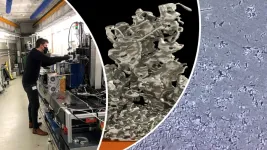(Press-News.org) Innovative battery researchers have cracked the code to creating real-time 3D images of the promising but temperamental lithium metal battery as it cycles. A team from Chalmers University of Technology, Sweden, have succeeded in observing how the lithium metal in the cell behaves as it charges and discharges.
The new method may contribute to batteries with higher capacity and increased safety in our future cars and devices.
“We’ve opened a new window in order to understand – and in the long term to optimise – the lithium metal batteries of the future. When we can study exactly what happens to the lithium in a cell during cycling, we gain important knowledge of what affects its inner workings,” says Aleksandar Matic, professor at the Department of Physics at Chalmers and head of the scientific study that was recently published in Nature Communications.
There are high hopes that new battery concepts, such as lithium metal batteries, will be able to replace today’s lithium-ion batteries. The goal is to develop more energy-dense and safer batteries that will take us further at a lower cost – both financially and environmentally. Solid-state batteries, lithium-sulphur batteries and lithium-oxygen batteries are among those being held up as promising alternatives. All of these concepts build on the idea that the battery anode, consists of a lithium metal instead of the graphite that is in today’s batteries. Without graphite, the battery cell will be lighter, and with lithium metal as the anode it will also be possible to use high-capacity cathode materials. This makes it possible to achieve three to five times the energy density.
Lithium forms undesired microstructures
However, lithium metal batteries have one crucial problem: when battery is charged or discharged, the lithium does not always deposit as flat and smooth as it should. Often, it forms mossy microstructures or dendrites, long needle like structures , and parts of the deposited lithium can become isolated and are then inactive. Dendrites, also risk reaching the other battery electrode and cause a short circuit. Therefore, it is crucial to understand when, how and why these structures form.
“To be able to use this technology in the next generation of batteries, we need to see how a cell is affected by factors such as current density, the choice of electrolyte and the number of cycles. Now we have a tool to do so,” says Chalmers researcher Matthew Sadd, head author of this new study along with his colleague Shizhao Xiong.
Excited wait for the first glimpse
The experiment to observe the formation of lithium microstructures in a working cell was conducted at the Swiss Light Source outside Zurich in Switzerland. In breathless anticipation, the researchers prepared a specially designed battery cell to study when lithium is deposited, in real time and in 3D using X-ray tomographic microscopy. Although many researchers have wanted to study lithium metal in a working cell, no one had been able to do so as far as the team knew. If they succeeded, it would be a major step forward, compared with analysing images after a cell has been cycled.
“It was magical when we saw with our own eyes that it worked on the first attempt,” Matic said. “When we observed the lithium creating big structures, like huge needles, it was almost like being in a lunar landing project. We’ve been wanting to observe the inner workings of batteries in real time for so long. And now we can.”
Key piece of the puzzle for large-scale use
Now the research team aims to test the technique on other battery concepts, hoping that the necessary imaging technology will be available closer to home, for example at the Swedish MAX IV lab, a national research facility for advanced x-ray experiments.
“We’re looking forward to developing this method to take faster measurements at higher resolution to see more detailed microstructures formed early on in the deposition process,” Matic says. “This is a key piece of the puzzle to be able to use lithium metal batteries on a large scale and make them safe. A lot of research teams and companies are looking at the lithium metal concept for their future prototypes.”
More about the research
The article Investigating microstructure evolution of lithium metal during plating and stripping via operando X-ray tomographic microscopy was published in Nature Communications and was written by Matthew Sadd, Shizhao Xiong, Jacob R. Bowen, Federica Marone and Aleksandar Matic. The researchers work at Chalmers University of Technology in Sweden, Xnovo Technology ApS in Denmark and the Paul Scherrer Institute at the Swiss Light Source in Switzerland.
The research was funded by Vinnova, the BASE excellence centre and Chalmers’ Energy Area of Advance.
In collaboration with international colleagues, Aleksandar Matic’s research team at Chalmers has published several results on how lithium is distributed when lithium metal batteries are charged and discharged, such as Insight Into The Critical Role of Exchange Current Density on Electrodeposition Behaviour of Lithium Metal in Advanced Science and Role of Li‐Ion Depletion on Electrode Surface: Underlying Mechanism for Electrodeposition Behavior of Lithium Metal Anode in Advanced Energy Materials.
More about the batteries of today and the next generation of batteries
In the search for the next generation of energy-dense, resource-conserving batteries, lithium metal batteries are one of the promising concepts. The hope is that the new battery type will replace today’s lithium-ion batteries, particularly in various types of electric vehicles. The goal is to develop energy-dense, safe batteries that will take us further at a lower cost – both financially and environmentally.
In lithium-ion batteries, the lithium is stored in graphite, which itself does not contribute to the activity. In lithium metal batteries, the graphite is replaced with lithium metal, which makes the battery more energy dense. With lithium metal as the anode, it is also possible to use high-capacity cathode materials. This can result in batteries with three to five times the energy density of today’s batteries.
Solid-state batteries, lithium-sulphur batteries and lithium-oxygen batteries are three examples of promising next generation battery concepts. All of these require lithium metal on the anode side to match the capacity of the cathode and maximise the energy density of the cell.
So far, the researchers surmise that the breakthrough for the next generation of batteries is some ten years away.
At Chalmers University of Technology, research is underway in a number of battery-related projects, and the researchers are involved in national and international collaborations, like the Swedish BASE excellence centre and the major European 2030+ BIGMAP project.
For more information, please contact:
Aleksandar Matic, Professor, Department of Physics, Chalmers University of Technology, +46 31 772 51 76, matic@chalmers.se
Matthew Sadd, Post doc, Department of Physics, Chalmers University of Technology, matthew.sadd@chalmers.se
Shizhao Xiong, Post doc, Department of Physics, Chalmers University of Technology, +46 76 218 49 51
shizhao.xiong@chalmers.se
END
3D battery imaging reveals the secret real-time life of lithium metal cells
2023-03-09
ELSE PRESS RELEASES FROM THIS DATE:
Naturally occurring peptide may tackle the ‘root cause’ of obesity-related conditions
2023-03-09
Research published today shows that a peptide (small protein) called PEPITEM could provide a revolutionary approach to reducing the risk of type 2 diabetes and other obesity-related diseases such as hepatic steatosis (fatty liver).
The researchers used an animal model of obesity to investigate whether PEPITEM, delivered by a slow-release pump, could prevent or reverse the effects that a high fat diet has on the pancreas. Excitingly, the results showed that administration of PEPITEM significantly reduced the enlargement of insulin-producing cells in the pancreas and ...
C-reactive protein reduces the immune response in inflammatory disease
2023-03-09
The biological function of the C-reactive protein, CRP, has long been unknown. Researchers at Linköping University in Sweden now show that this protein has a beneficial function in systemic lupus erythematosus, SLE, an inflammatory disease. But this is true only for one of CRP’s two forms, according to the study published in Journal of Autoimmunity.
Most of us have had a CRP blood test on more than one occasion. This is a very common routine health care test used to detect infection or systemic inflammation in the body. What is measured is the level of C-reactive protein, or CRP for short.
“CRP ...
Study: Higher fracture risk after total hip replacement when cementless implant used to treat femoral neck fracture
2023-03-09
A study by Hospital for Special Surgery (HSS) and other centers found that total hip replacement performed with a cementless prosthesis for a femoral neck fracture led to a higher rate of a second fracture and subsequent revision surgery. The research was presented today at the American Academy of Orthopaedic Surgeons (AAOS) Annual Meeting in Las Vegas. The results were also published online in The Journal of Arthroplasty in October 2022.
Treatments for a femoral neck fracture range from nonoperative management to total hip replacement. When hip replacement is the best treatment option, it can be performed with or without bone cement to secure the prosthesis.
“Femoral ...
Mass General researchers discover the role of intestinal fibrosis in inflammatory bowel disease
2023-03-09
Intestinal fibrosis is a common feature of inflammatory bowel disease (IBD) and the primary cause of end-stage organ failure. Traditionally considered a bystander of inflammation, with negligible involvement in disease pathogenesis, new research published in Gastroenterology now shows that fibrosis has a direct bearing on disease progression in IBD.
The investigation was spearheaded by Nima Saeidi, PhD, Associate Professor of Surgery at the Massachusetts General Hospital (MGH) and Harvard Medical School, along with co-first authors, Shijie He, PhD, and Peng Lei, PhD.
The critical question posed by the investigators ...
Digital rectal examination is not useful to early detect prostate cancers
2023-03-09
A common method of detecting prostate cancer may not be accurate enough as a reliable screening tool by itself, scientists have warned.
The digital rectal exam (DRE) is widely used by medical professionals to check the prostate gland with a finger for unusual swelling or lumps in the rectum as an initial check for the signs of prostate cancer in men.
In some countries, such as Germany, it is the sole method used in a national screening programme for the disease.
But new research by scientists of the PROBASE trial coordinated at the German Cancer Research Center (Deutsches Krebsforschungszentrum, DKFZ) ...
Long Covid is much less likely after omicron than after variant circulating at start of COVID-19 pandemic
2023-03-09
**Note: the release below is a special early release from the European Congress of Clinical Microbiology & Infectious Diseases (ECCMID 2023, Copenhagen, 15-18 April). Please credit the conference if you use this story**
Embargo: 2301H UK time Wednesday 8 March
The omicron variant of SARS-CoV-2 is much less likely to lead to long Covid than the variant circulating at the start of the COVID-19 pandemic, new research being presented at this year's European Congress of Clinical Microbiology & Infectious Diseases (ECCMID 2023, Copenhagen, 15-18 April) suggests.
The Swiss study found that healthcare ...
World’s most comprehensive study on COVID-19 mental health
2023-03-09
COVID-19 has taken a relatively limited toll on the mental health of most people around the globe, according to a paper published today in the BMJ by a McGill University-led research team involving collaborators from McMaster University, the University of Toronto, and other institutions.
The team reviewed data from 137 studies in various languages involving 134 cohorts of people from around the world. Most of the studies were from high or middle-income countries, and about 75% of participants were adults and 25% were children and adolescents between the ages of 10-19.
To their surprise, the researchers found that despite the dramatic stories to the contrary, where ...
Low dose radiation linked to increased lifetime risk of heart disease
2023-03-09
Exposure to low doses of ionising radiation is associated with a modestly increased excess risk of heart disease, finds an analysis of the latest evidence published by The BMJ today.
The researchers say these findings “have implications for patients who undergo radiation exposure as part of their medical care, as well as policy makers involved in managing radiation risks to radiation workers and the public.”
And a linked editorial suggests that these risks “should now be carefully considered in protection ...
Study suggests little deterioration in mental health linked to the pandemic
2023-03-09
Mental health among the general population has not changed by large amounts during the covid-19 pandemic compared with pre-pandemic levels, finds a study published by The BMJ today.
Some specific groups, particularly women, appear to have been more negatively affected, but changes have been minimal to small, say the researchers.
Many studies and media reports suggest that covid-19 has led to widespread decline in mental health, but inconsistencies in study quality and misinterpretation of cross-sectional data may ...
Can children map read at the age of four?
2023-03-09
Children start to develop the basic skills that underlie map reading from the age of four – according to new research from the University of East Anglia.
A new study published today reveals that they become able to use a scale model to find things in the real world.
The study involved 175 two to five-year-olds and is the largest of its kind.
The team say that this new spatial ability potentially lays the foundations for maths and science skills.
Lead researcher Dr Martin Doherty, from UEA’s School of Psychology, said: “We wanted to find out when children can use scale models or maps ...



